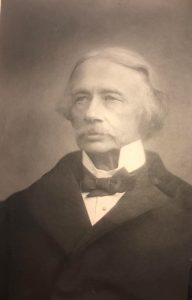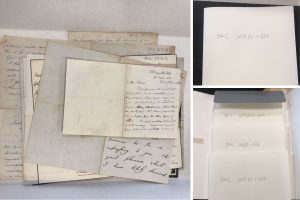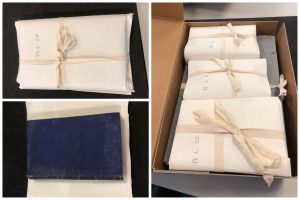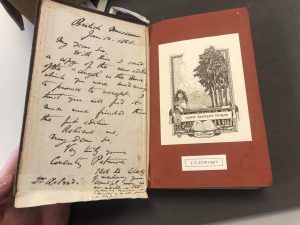August 15, 2023, by Kathryn Summerwill
Working with the Coventry Patmore Collection
This is a guest blog by School of English Placement student Louise Roberts, who in 2023 worked on cataloguing additional papers of Coventry Patmore (1823-1896)
When learning about Victorian literature, there is no doubt that Coventry Patmore’s poem The Angel of the House will be mentioned as one of the most influential pieces of literature of the time, yet his name is not one as well-remembered as his contemporaries Charles Dickens, Elizabeth Barrett Browning, Thomas Hardy. In his day Patmore was celebrated by both authors and the public alike, but has been largely forgotten over time despite the influence he had on our canonical favourites. The University of Nottingham’s Coventry Patmore collection, initially created by the donations of Professor R.M. Hewitt of University College Nottingham (more details available on the catalogue record), is a remedy against Patmore’s name being forgotten. The collection preserves the high regard with which his peers kept him in the many correspondences to and from Patmore alongside some of his fiction and non-fiction works that illustrate his intellect and skill.
The Technical Details
I did some volunteer work on parts of the collection that had not yet been catalogued to help make them available to the public. This involved writing appropriate descriptions of each item in equal detail and providing them with a temporary catalogue number to keep track of their location. I then organised the items into groups to better understand how they should be categorised within the collection. After coming up with a suitable system of organisation with my placement supervisor, I replaced the temporary catalogue numbers with permanent ones to reflect their new place in the collection.
It was then necessary to reorganise the items physically, labelling them with their new catalogue numbers and bundling them using conservation-friendly methods. Before starting my placement, I had to undertake care and handling training of the collection items to minimise the chance of damage occurring during my access to them. In my training, I was taught the correct methods to package the materials, using acid-free paper which is more durable and has a longer lifespan than regular paper as well as brass paperclips that do not rust. The avoidance of over-filling was another key aspect to the bundling process, preventing the materials being under strain while compacted. When the storage boxes used for archiving are overfilled, this can cause damage to the materials, especially to paper and the spines of books, which can become torn and creased, and bow when over-compressed. In the case of the numerous correspondences, this meant creating several mini-bundles to be packaged together to conserve them more safely, and creating bundles specific to the size of larger, individual volumes.
The Collection Itself
The Coventry Patmore collection contains some prized items for Patmore-ians, ranging from little-seen portraits he had taken, to private correspondences between his family, friends, and publishers. As an English student, I found his notebook of composition for his famed poem The Angel in the House, which is extensively filled with ideas, potential lines of verse, and crossed-out notes particularly interesting. This item pairs nicely with the publication of his first two books of his four-book poem, donated to the British Museum by Patmore himself, and containing the letter that accompanied this donation pasted to its inside cover.
The correspondence offers a different insight into Patmore’s life. While he has been largely forgotten by the public, the many correspondences written to, from, and about Patmore in the collection preserve his generous nature, sense of humour, and kindness to the people whom he kept as company, and who these people were. One particular item (a favourite of mine) records a bet made between Patmore and F. Lawrence, as to whether the Duc de Bordeaux will be king of France within the next twelve years and the length of his reign, wagered at 10 shillings to 10 pounds (Pt L 52). It is items like these that illustrate Patmore’s good humour and the types of relationships he kept with those around him, and it is when looking at the collection as a whole that the sheer quantity of valued relationships Patmore maintained is revealed. Evidently he was more than an influential author to his contemporaries, but a dear friend too.
Further information
The catalogue for the Papers and Correspondence of Coventry Patmore (1823-1896), poet and writer, can by accessed via the Manuscripts Online Catalogue (Document Reference Pt). The papers can be accessed in the Manuscripts and Special Collections reading room at King’s Meadow Campus.
No comments yet, fill out a comment to be the first






Leave a Reply